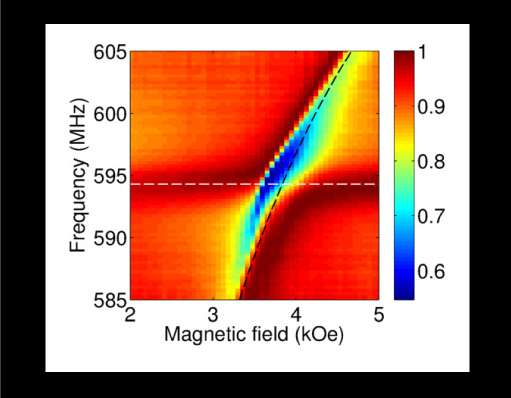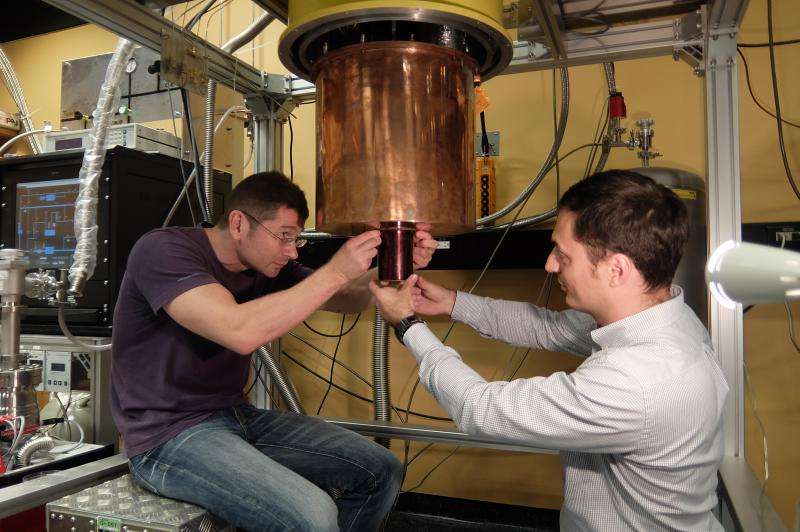Quantum computer storage may require the help of an intermediary to transmit information

Researchers at the Okinawa Institute of Science and Technology Graduate University (OIST) have identified a system that could store quantum information for longer times, which is critical for the future of quantum computing. This study was recently published in Physical Review Letters.
Quantum computing—which aims to use particles on the atomic scale to make calculations and store the results—has the potential to solve some key problems much faster than current computers.
To make quantum computing a reality, scientists must find a system that remains stable long enough to make the calculations. While this is an extremely short time frame, only thousandths of a second, the particles involved are so small that they are easily influenced by their surroundings. If the motion of the particles is disturbed, even a little, it throws off the whole calculation.
Nuclei are promising contenders for quantum memory because they are not easily influenced by their surroundings. However, that also makes them extremely difficult to manipulate. Many quantum physicists have tried with little success.
"In usual materials it is very difficult to control nuclei directly," said Prof. Denis Konstantinov, who runs the Quantum Dynamics Unit at OIST.
Instead of trying control the nucleus directly, the researchers focused on a "middle man" of sorts – the electrons orbiting the nucleus.
The nucleus has a tiny internal magnet, called a "magnetic moment," and the electrons orbiting around it also have magnetic moments that are about 1,000 times larger. Those magnets interact with each other, which is called the "hyperfine interaction."

The hyperfine interaction is stronger in some materials than others. The researchers found that a crystal made of manganese and some other elements has a strong hyperfine interaction. This enabled them to manipulate the nuclei by first targeting the electrons.
Information in quantum computing is conveyed by photons, which are individual particles of light, which also make up other nonvisible electromagnetic waves, such as ultraviolet and microwaves. The information transmitted is actually the quantum state of the photon. The quantum state of the photon needs to be transferred to another particle so it will last long enough for the computation to take place.
In this experiment, the researchers beamed microwaves through a manganese carbonate crystal. The magnetic field of the microwaves interacted with the magnetic moments of the electrons that are orbiting around the nuclei of the manganese atoms. The electrons' movements started to change, which in turn altered the movement of the nuclei because they are connected by the hyperfine interaction. The quantum state of the microwave photon was transferred to the nuclei when the nuclei's internal magnets flipped to point in the opposite direction.
This all has to happen very quickly before the quantum state of the photon changes. To transmit the information and flip the nuclei fast enough, there has to be a strong connection between the microwaves and nuclei via the electrons.
"To our knowledge, our experiment is the first demonstration of the strong coupling between microwave photons and nuclear spins," said Leonid Abdurakhimov, a post-doctoral scholar at OIST and first author of the paper.
Next, the team plans to cool down the system to nearly -273 C, or -500 F, to see if they can strengthen the connection and extend the time information can be stored by minimizing temperature fluctuations.
"We are making the first and important steps towards using an ensemble of nuclear spins for quantum memory," Konstantinov said. "We now have a whole class of materials that can be used for this purpose. Future experiments promise to be quite exciting."
More information: "Normal-Mode Splitting in the Coupled System of Hybridized Nuclear Magnons and Microwave Photons" Phys. Rev. Lett. 114, 226402 – Published 3 June 2015 journals.aps.org/prl/abstract/ … ysRevLett.114.226402
Journal information: Physical Review Letters
Provided by Okinawa Institute of Science and Technology




















